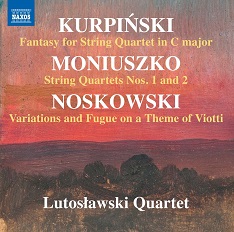Streichquartette oder Sätze für die Besetzung über ein Jahrhundert bietet die neue Aufnahme des Lutoslawski Quartetts. Von Zygmunt Noskowski sind die Variationen und Fuge über ein Thema von Viotti zu hören. Das Thema aus dem zweiten Satz der Violinsonate Nr. 2 von Viotti wird gleichmäßig über das ganze Stück verwendet.Die acht Variationen variieren dabei zwischen lebhaften Wechselspielen sowie lyrischen und aggressiven Momenten, bevor eine aufgeregte Polacca die Schlussfuge vorbereitet.
Die beiden Streichquartette von Stanislaw Moniuszko zeigen sich in traditioneller Form mit jeweils vier Sätzen. Herausheben aus diesen noch an Haydn und dem jungen Beethoven orientierten Werken mag man vielleicht im ersten Satz die hymnische Melodie des langsamen Satzes, die trotz ihrer Kürze eine beachtliche Ausdruckstiefe aufweist und den Schlusssatz, der mit rustikalem Anstrich und rhythmischem Profil an volkstümliche Quellen erinnert. Das Allegro moderato des zweiten Quartetts ist mit rhythmischer Prägnanz in der Durchführung und einer stark fugierten Episode gegen Ende der gehaltsvollste aller acht Sätze. Mit düsterem Charakter bestimmt ein choralartiges Thema den musikalischen Inhalt des zweiten Satzes, während Witz und Humor das Scherzo prägen. Den Schlusssatz bestimmt ein ungehemmt energischer Kurs, der erst am Ende den Beginn sanft und unerwartet in Erinnerung ruft.
Die Fantasie für Streichquartett von Karol Kazimierz Kurpinski lässt an Cherubini denken, wenn man die Ernsthaftigkeit des Ausdrucks sowie den Einfallsreichtum betrachtet.
Das Lutoslawski Quartet widmet sich den Werken ernsthaft und zeigt die unterschiedlichen Stimmungen mit feinem Gespür für den jeweiligen Charakter. Mögen auch die Stücke nicht zu den herausragenden Beispielen der Quartettliteratur zählen, so zeigen die engagierten Interpretationen des Quartetts doch die Eigenständigkeit dieser Komponisten. Und sie lassen den Charme dieser hörenswerten Musik aufleben. Dabei entfalten sie das Stimmengeflecht der Partituren in ausgewogenem Miteinander der vier Instrumente. Vielleicht ist die Akustik der Aufnahme ein wenig trocken, aber das stört den vorteilhaften Gesamteindruck nicht.
String quartets or movements for instrumentation spanning a century are offered by the Lutoslawski Quartet’s new recording. Zygmunt Noskowski’s Variations and Fugue on a Theme by Viotti can be heard. The theme from the second movement of Viotti’s Violin Sonata No. 2 is used evenly throughout the piece. The eight variations here vary between lively interplay and lyrical and aggressive moments before an excited polacca prepares the final fugue.
The two string quartets by Stanislaw Moniuszko present themselves in traditional form with four movements each. Out of these works, still oriented to Haydn and the young Beethoven, one might perhaps single out in the first movement the hymn-like melody of the slow movement, which despite its brevity displays considerable depth of expression, and the final movement, which with rustic overtones and rhythmic profile recalls folk sources. The Allegro moderato of the second quartet is the most substantial of all eight movements, with rhythmic concision in the development and a strongly fugal episode near the end. With a somber character, a chorale-like theme determines the musical content of the second movement, while wit and humor characterize the scherzo. The final movement is determined by an uninhibitedly energetic course that only at the end gently and unexpectedly recalls the beginning.
The Fantasy for String Quartet by Karol Kazimierz Kurpinski makes one think of Cherubini, considering the seriousness of expression as well as the ingenuity.
The Lutoslawski Quartet devotes itself seriously to the works, displaying the different moods with a fine sense of character. While the pieces may not rank among the outstanding examples of quartet literature, the quartet’s committed interpretations demonstrate the independence of these composers. And they bring to life the charm of this music worth hearing. In doing so, they unfold the web of voices of the scores in a balanced interplay of the four instruments. Perhaps the acoustics of the recording are a bit dry, but that does not disturb the favorable overall impression.




















